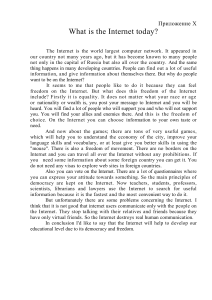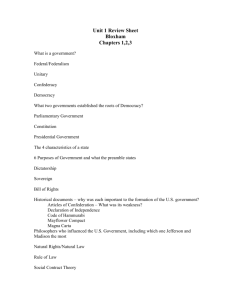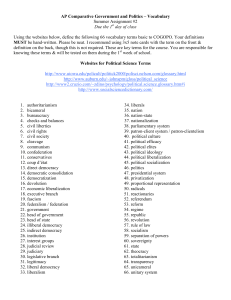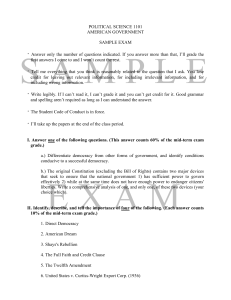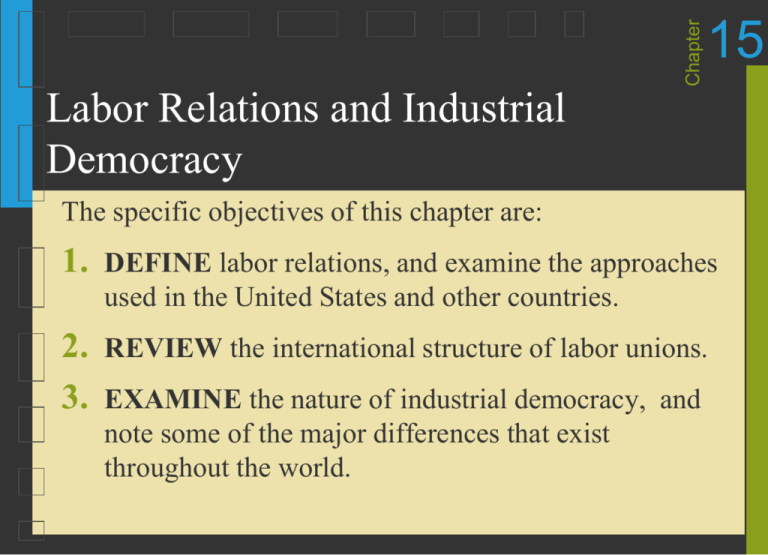
Chapter
15
Labor Relations and Industrial
Democracy
The specific objectives of this chapter are:
1. DEFINE labor relations, and examine the approaches
used in the United States and other countries.
2.
3.
REVIEW the international structure of labor unions.
EXAMINE the nature of industrial democracy, and
note some of the major differences that exist
throughout the world.
Chapter
Labor Relations and Industrial
Democracy
The specific objectives of this chapter are:
4. DESCRIBE the philosophical views and strategic
approaches that MNCs use to manage international
industrial relations and future strategies.
15
3
Labor Relations in the
International Arena
The U.S. Approach to
Labor Relations
Collective Bargaining
The process whereby formal labor agreements are reached by
union and management representatives; it involves the
negotiation of wages, hours, and conditions of employment
and the administration of the labor contract.
Union
An organization that represents the workers and in collective
bargaining has the legal authority to negotiate with the
employer and administer the labor contract.
4
Labor Relations in the
International Arena
The U.S. Approach to
Labor Relations
Steps of a Grievance
Procedure
Efforts are made to solve problems at the lowest level of the hierarchy
as quickly as possible
First step usually involves a meeting between the union representative
(shop steward) at the operating level and the employee’s supervisor –
they attempt to agree on how to solve the grievance
Unresolved grievances may involve union officials and higher-level
management representatives – these conciliatory approaches usually
solve the grievance
Sometimes the matter ends up in the hands of a mediator or an
arbitrator
5
Labor Relations in the
International Arena
The U.S. Approach to
Labor Relations
Mediator
Mediation and Arbitration
A person who brings both sides (union and management
representatives) together and helps them to reach a settlement
that is mutually acceptable.
Arbitrator
An individual who provides a solution to a grievance that both
sides (union and management representatives) have been
unable to resolve themselves and that both sides agree to
accept.
6
Labor Relations in the
International Arena
The U.S. Approach to
Labor Relations
Mediation and Arbitration
Three of the most common arbitration approaches for resolving
wage-related issues include:
50/50 Split
Splitting the difference between the
demands of the two parties
Either/Or
Using an either-or approach: one position
is fully supported and the other is rejected
What’s Fair?
Determining a fair wage based on market
conditions
7
Labor Relations in the
International Arena
The U.S. Approach to
Labor Relations
Importance of Positive
Labor Relations
They directly determine labor costs, productivity, and
eventually, even profits
Labor costs in the United States are lower in recent years
than in most other major industrial countries.
Thanks to union–management cooperation, U.S. companies
have been able to introduce high-tech, efficient machinery.
Much of this outcome is a result of effective labor relations
strategies.
8
Labor Relations in the
International Arena
Labor Relations in Other
Countries
Labor relations strategies vary greatly from country to
country—the strategy used in one country is sometimes
irrelevant or of limited value in another.
A number of factors can account for this:
Economic development of the country
Entry strategies must often be modified
Changes in the political environment
Strike activity
Other differences are more regional
9
Labor Relations in the
International Arena
Labor Relations in Other
Regional Differences
Countries
EUROPE
European firms typically negotiate agreements with unions
at the national level
Many European unions have more political power than U.S.
unions
Salaried employees in Europe (including those at
managerial levels) often have unions of their own
European unions have existed longer than those in the
United States and occupy a more accepted position in
society
10
Labor Relations in the
International Arena
Labor Relations in Other
Regional Differences
Countries
In developing and emerging economies such as China,
India, and Southeast Asia:
Labor is less powerful
Unions are less prevalent
Workers are often compelled to accept conditions of work
set by management
11
Percentage of Trade-Union Members, 2001
Denmark
Sweden
Ireland
Austria
Italy
Germany
Britain
Netherlands
Japan
Spain
United States
France
0
20
40
60
80
100
Adapted from Figure 15–1: Percentage of Employed People Who Were Trade-Union Members, 2001
12
Labor Relations in the
International Arena
Labor Relations in Other Differing Approaches to
Countries
Industrial Relations
Great Britain
A labor agreement in Great Britain is not a legally binding
contract
Violations of the agreement by the union or by management carry
no legal penalties
British unions are relatively powerful and strikes are more
prevalent than in the United States
British union membership has declined in recent years
British labor agreements do not usually include provisions for
arbitration of disagreements or grievances
13
Labor Relations in the
International Arena
Labor Relations in Other Differing Approaches to
Countries
Industrial Relations
Germany
Rights of workers are addressed more carefully by management
Union power in Germany is still quite strong
Union membership is voluntary—generally one union in each
major industry
A minority of the labor force is organized
Individual workers are free to negotiate either individually or
collectively with management to secure wages and benefits that
are superior to those spelled out in the agreement even when
covered by a labor contract
14
Labor Relations in the
International Arena
Labor Relations in Other Differing Approaches to
Countries
Industrial Relations
Japan
Social custom dictates nonconfrontational union–management
behavior
Provisions in Japanese labor agreements are usually general and
vague, although they are legally enforceable
Agreement disputes are settled in an amicable manner though
sometimes resolved by third-party mediators or arbitrators
Labor commissions have been established by law
Japanese unions remain relatively weak.
15
Labor Relations in the
International Arena
Labor Relations in Other Differing Approaches to
Countries
Industrial Relations
China, India, and Southeast Asia
Labor relations in the developing and emerging economies of the
world are quite distinct from those in industrial democracies:
Economic employment conditions generally favor owners over
workers
Employees have less power and are less likely to initiate actions or
organize unions to negotiate for improved working conditions
16
Labor Relations in the
International Arena
Labor Relations in Other Differing Approaches to
Countries
Industrial Relations
China
The Chinese economy has shifted from a command economy to a
more market-led one
An increasing emphasis is being placed on the role of the
collective contract system
Integration of trade unions into workplace management continues
to prevent collective consultation from providing an adequate
framework for the full freedom and regulation of labor relations
Labor relations in China has become a point of contention in
international trade and human rights discussions
17
Labor Relations in the
International Arena
Labor Relations in Other Differing Approaches to
Countries
Industrial Relations
Southeast Asia including Brunei, Cambodia, East Timor, Indonesia,
Laos, Malaysia, Myanmar (Burma), Philippines, Singapore, Thailand,
and Vietnam
Many states are still focused on keeping labor movements in
check, whether in the name of economic development, national
unity, or social stability
Labor movements are fragmented or constrained due to the
political environment
Labor relations in Southeast Asia have been influenced by marketbased policies of international competition
Thomas Friedman – The World is Flat
18
Labor Relations in the
International Arena
Industrial Conflict
Around the World
Strike
A collective refusal to work to pressure management to grant
union demands
Lockout
A company’s refusal to allow workers to enter the facility
during a labor dispute
19
Annual Average Days Lost Due to Labor Disputes
1993-2002
554
250
200
150
100
50
Austria
Japan
Switzerland
Germany
Netherlands
Portugal
Britain
Belgium
New Zealand
Sweden
United States
Australia
Ireland
Norway
France
Finland
Italy
Denmark
Canada
Spain
Iceland
0
Adapted from Figure 15–2: Annual Average Days Lost Due to Labor Disputes in Economically-Advanced Nations, 1993–2002
20
Labor Relations in the
International Arena
Industrial Conflict
Around the World
United States
Most U.S. labor contracts have a specific provision that outlaws
strikes; thus, sudden or unauthorized strikes (commonly called
“wildcat strikes”) are uncommon.
The grievance procedure is used to resolve the disagreements
peacefully
Once the contract period is over and if a new one is not
successfully negotiated:
Workers may strike or continue to work without a contract
while threatening to walk out
Management also may lock out the workers—very rare
21
Labor Relations in the
International Arena
Industrial Conflict
Around the World
Great Britain
Labor unions are relatively powerful (has decreased in recent
years)
Strikes are more prevalent than in the United States
Labor agreements typically do not prohibit strikes and the general
public is more used to and tolerant of them
System is not geared toward the efficient resolution of problems
British in general still appear willing to accept conflict with
resulting strikes and lockouts as the price of protecting the rights
of the workers
22
Labor Relations in the
International Arena
Industrial Conflict
Around the World
Germany
Strikes and lockouts are prohibited in Germany during the period
when a labor agreement is in effect
A strike is legal when the contract has run out and a new one has
not yet been ratified by the workers
German unions tend to be industrywide—a company quite often
has several agreements in force with different termination dates
There tends to be a fair amount of cooperation between
management and labor because of the way labor relations are
legally structured
23
Labor Relations in the
International Arena
Industrial Conflict
Around the World
Japan
Strikes and lockouts in Japan are very rare
Japanese workers sometime strike when a union is negotiating
with management during industrywide negotiations to show
support for their union
Cultural value of Wa implies that individuals should subordinate
their interests and identities to those of the group
Accounts for much of the harmony that exists between management
and labor in Japan.
24
International Structure of Unions
Most labor unions are locally or nationally based – some
are active internationally
Three basic ways Union internationalization has been
achieved
Intergovernmental Organizations
Transnational Union Affiliations
Extension of Domestic Contracts
25
International Structure of Unions
Intergovernmetnal
Organizations
Grievance
A complaint brought by an employee who feels that he or she
has been treated improperly under the terms of the labor
agreement.
26
International Structure of Unions
Intergovernmetnal
Organizations
There are two important intergovernmental organizations:
International Labour
Organization (ILO)
A United Nations affiliate
Consists of government, industry,
and union representatives
Works to promote fair labor
standards in health, safety, and
working conditions, and freedom of
association for workers
27
International Structure of Unions
Intergovernmetnal
Organizations
There are two important intergovernmental organizations:
International Labour
Organization (ILO)
Organization for
Economic Cooperation &
Development (OECD)
A government, industry, and union
group founded in 1976 that has
established a voluntary set of
guidelines for MNCs
28
International Structure of Unions
Transnational Union
Affiliations
There are four basic types of international trade affiliations:
Global
Global international trade-union
affiliations
Trade-union relationships that cut across
regional and industrial groups and are
heavily concerned with political activities
International Confederation of Free Trade Unions (ICFTU)
The most important global international union confederation.
29
Industrial Democracy
Common Forms of
Industrial Democracy
The European Commission has stated that a primary objective
is to obtain a minimum threshold of social rights for workers,
to be negotiated between a “European union” and employers
Several forms of industrial democracy exist in European
countries and elsewhere
One
form may be more prevalent than others in some
countries
It
is common to find a number of these forms
existing simultaneously
30
Industrial Democracy
Common Forms of
Industrial Democracy
Codetermination
Involves the participation of workers on boards of directors
The EU Council of Ministers recently issued a directive
requiring all companies with 50 or more employees to “inform
and consult” workers’ representatives about company strategy
by 2008
Some researchers report that the workers are not greatly
impressed with codetermination – many regard such
participation on boards as merely a cosmetic attempt to
address the substantive issue of true industrial democracy
31
Industrial Democracy
Common Forms of
Industrial Democracy
Work Councils
Work councils exist in all European countries
Basic function is to improve company performance,
working conditions, and job security
Some councils are worker- or union-run – others are
chaired by members of management
Workers are elected typically to serve on the council
Management representatives are appointed by the company
32
Industrial Democracy
Common Forms of
Industrial Democracy
Shop Floor Participation
Some common forms of shop floor participation
include:
Worker involvement programs
Quality circles
Other forms of participative management
QWL (quality of work life) programs are currently popular
in manufacturing and assembly plants
33
Industrial Democracy
Common Forms of
Industrial Democracy
Financial Participation
Most common forms of financial participation:
Profit sharing between management and workers
Productivity or gain-sharing – management and workers
share productivity gains in a predetermined ratio
Has not been widely adopted overseas
Has gained a foothold in a number of U.S. firms,
especially those using gain sharing as a team
incentive for performance improvement
34
Industrial Democracy
Common Forms of
Industrial Democracy
Collective Bargaining
Can become the mechanism to obtain industrial
democracy for workers if no specific forms of industrial
democracy are in effect
The ability of unions to bargain collectively is legally
restricted in some countries
Some nations require collective bargaining
35
Industrial Democracy
Industrial Democracy in
United States
Selected Countries
Collective bargaining is the most common form of
industrial democracy – guidelines are spelled out by law
NLRB certified unions become the exclusive bargaining
agent for employees authorized to represent workers in
negotiation and administration of labor–management
contracts
36
Industrial Democracy
Industrial Democracy in
United States
Selected Countries
Problem-solving
Teams
Special Purpose
Teams
Self-managing
Teams
Employee groups discuss ways to improve
quality, efficiency, and overall work
environment
Employee groups that design and introduce
work reforms and new technology
Employee groups perform supervisory duties
and manage themselves
Consist of individuals who learn all the tasks
of all the group members
Team members rotate jobs
37
Industrial Democracy
Industrial Democracy in
Great Britain
Selected Countries
Industrial democracy in Great Britain takes the form of
collective bargaining and worker representation through the
use of teams
British work groups elect a chief spokesperson or steward to
interface with management
Union councils represent unionized employee to ensure
workers are treated fairly by management
This may create a problem if the spokespersons or
stewards in the firm disagree with the union councils.
38
Industrial Democracy
Industrial Democracy in
Germany
Selected Countries
Industrial democracy and codetermination strong in Germany
Unions are charged with handling the collective bargaining
German law has established internal boards to ensure codeterminism
in the workplace
Supervisory boards are similar to a board of directors in U.S.
firms
Management boards are responsible for daily operation
Employees in each plant elect a plant work council
Members of plant work councils in multiplant companies also
serve on a company work council
39
Industrial Democracy
Industrial Democracy in
Denmark
Selected Countries
Danish workers participate in the management of their firms both
directly and indirectly
Direct form includes use of semiautonomous work groups that
provide ideas on enhancing productivity and quality and on
scheduling the work.
Indirect form includes use of shop stewards on the work floor,
representation on boards of directors, cooperation committees
consisting of worker and manager representatives, safety groups
made up of a supervisor and an elected employee representative,
and participation on safety committees that are headed by a
manager.
40
Employee Participation in All Levels of Danish Firms
Board
Safety Committee
Director(s)
Upper/middle Management
Safety Group
Cooperation
Committee
Partly
Autonomous
Groups
Employees
Trade Union Club
Adapted from Figure 15–3: Employee Participation in All Levels of Danish Firms
Shop Steward
41
Industrial Democracy
Industrial Democracy in
Sweden
Selected Countries
Industrial democracy in Sweden is directed very heavily toward
ensuring quality of work life (QWL) and worker participation in the
operation of the enterprise
Semiautonomous work teams and a cooperative spirit between
management and workers are key elements of Swedish industrial
democracy
Swedish firms have workers as members of their board of directors
Worker board participants receive formal training and spend time with
other workers on the board to ensure they are competent in their tasks
42
Industrial Democracy
Industrial Democracy in
China
Selected Countries
Chinese enterprises traditionally had two policy-making committees
Communist
Party leaders and members
Managers and worker representatives
The political climate determined which committee had more power
After reforms in the 1980s, the workers (not the party members)
represented industrial democracy in communist countries
The Chinese government has agreed to an ambitious program of
cooperation with the ILO which will provide advice on such things
as job creation, workplace safety, collective bargaining, and the
settlement of labor disputes.
43
Industrial Democracy
Industrial Democracy in
Japan
Selected Countries
Industrial democracy in Japan is not closely tied to political
philosophy
Japanese firms are oriented more to the operating philosophy of
enhancing worker performance
Management is receptive to workers’ ideas that will produce bottomline results
Due to the basic nature of Japanese union–management relations
there is very little industrial democracy in the European sense
44
Industrial Democracy
Industrial Democracy in
Japan
Selected Countries
Enterprise Unions
Unions that represent both hourly and salaried employees of a
particular company.
Employees join the union because they are members of the firm
and union membership is expected
They do not expect the union to negotiate and win big salary
increases for them
Many Japanese unions are relatively weak because they are
company dominated
45
Strategic Management of International
Labor Relations
The Philosophical
Backdrop
Ethnocentric
Philosophy
Approaches labor relations in other
countries identical to its approach
at home
Cultural, legal, and economic
factors of the host country are not
considered in industrial relations
efforts
Generally ineffective and can have
disastrous results
46
Strategic Management of International
Labor Relations
The Philosophical
Backdrop
Ethnocentric
Philosophy
Polycentric
Philosophy
Evaluates each country or
geographic region as a separate
entity
Will use a series of different
international industrial relations
strategies depending on the country
47
Strategic Management of International
Labor Relations
The Philosophical
Backdrop
Ethnocentric
Philosophy
Polycentric
Philosophy
Geocentric
Philosophy
Characterized by an effort to
understand interrelationships between
various geographic locations and a
strategy to link them with a unifying
thread and a composite industrial
relations approach
Primary difference between polycentric
and geocentric philosophies is that the
latter considers interrelationships
between the various groups
48
Strategic Management of International
Labor Relations
Labor Costs
Another major area of consideration in formulating an international
labor relations strategy is labor costs
Wages paid in one country often differ considerably from those paid
in other countries for the same job
Workers are grossly exploited in some countries – toiling for long
hours, in unsafe conditions, for minimum pay.
Labor costs some countries’ are extremely high – as in German In
manufacturing where hourly rates in have been substantially
greater than those paid elsewhere
49
Comparison of Average Weekly Hours
Worked in Manufacturing
Country
Germany
France
Italy
United States
Great Britain
Average Total Hourly
Compensation in U.S. Dollars
for Production Workers
$26.18
17.42
14.93
21.33
17.47
Average Weekly
Hours Worked
39.9
38.2
39.0
40.5
43.5
A close analysis of this information shows, in the main, that there is an
inverse relationship between hourly compensation and hours worked.
McGraw-Hill/Irwin
© 2006 The McGraw-Hill Companies, Inc. All rights reserved.
50
Strategic Management of International
Labor Relations
Labor Costs
By holding down weekly hours, unions have been able to increase the
hourly pay of their members
While real wages have increased, research shows that a growing
number of high-paid workers have found themselves priced out of the
market
Businesses are finding it easier to transfer work to other geographic
locales than to pay these high prices
51
Strategic Management of International
Labor Relations
New Labor Force
Trends and Pressures
Many European and to a lesser degree Asian
companies are trying
to regain some of the competitiveness they lost through high
labor costs
They face the same challenges their counterparts in the United States
began confronting a decade ago:
The workforce is being downsized
A strong focus is being placed on providing higher-quality output
at lower costs
52
Percentage Change in Manufacturing Unit
Labor Costs, 2001-2002
Denmark
Sweden
Ireland
Austria
Italy
Germany
Britain
Netherlands
-10
-5
0
5
10
Percent Change
15
20
Adapted from Figure 15–4: Percentage Change in Manufacturing Unit Labor Costs (U.S. dollar basis) in Selected Countries,
2001–2002
53
Strategic Management of International
Labor Relations
New Labor Force
Trends and Pressures
Part-Time Work and
Shiftwork
Part-Time Work
Most widely used form of flexibility in Europe
One in seven people in the EU is a part-time worker – during the
last few years this form of employment accounted for more new
jobs than any other
There are a large number of part-time workers in the United States
A growing number of MNCs are using part-time and temporary
contract workers
54
Strategic Management of International
Labor Relations
New Labor Force
Trends and Pressures
Part-Time Work and
Shiftwork
Shiftwork
Very popular in Europe
Widely used in newspaper production, public transportation,
utilities, food production, delivery services, hospitals,
emergency services, telephone sales, and banking
Very popular with employers in Italy, Sweden, Belgium,
England, France, and Germany
55
Strategic Management of International
Labor Relations
New Labor Force
Trends and Pressures
Nonpermanent
Employment
Any form of employment other than permanent open-ended
contracts
Popular in southern European countries such as Greece,
Portugal, and Spain, where it accounts for over 15 percent of
the workforce
Less popular in countries such as Luxembourg, Belgium, and
Italy, where only 5 percent of the employees have
nonpermanent employment contracts
56
Strategic Management of International
Labor Relations
New Labor Force
Trends and Pressures
Nonpermanent
Employment
Benefits of Using Nonpermanent Employment
Length or amount of work is uncertain
Some jobs require a limited period of time
Short-term recruitment is a cost-effective
Temporary employees do not get benefits
Special skills are needed quickly and inexpensively
Easy to terminate temporary workers when no longer needed
Good way to determine if someone will “fit in” on a permanent
basis
57
Strategic Management of International
Labor Relations
New Labor Force
Trends and Pressures
Subcontracting
Involves replacing employment contracts with
commercial contracts
Widely used in construction – workers move from one
contract to another or are laid off between jobs
Popular in European public sector and private
organizations that prefer to focus on their core business
58
Strategic Management of International
Labor Relations
New Labor Force
Trends and Pressures
Global Pressures for
Improved Labor Practices
MNCs are under increasing pressure to upgrade working conditions
and labor practices of manufacturing and other facilities
NGOs and other groups are pressuring MNCs to adhere to
international standards and adopt new codes of responsibility
The ILO addresses the conditions of workers through its standards
and conventions (international treaties), nonbinding
recommendations, codes of conduct, resolutions, and declarations
59
Strategic Management of International
Labor Relations
New Labor Force
Trends and Pressures
Global Pressures for
Improved Labor Practices
The Organization for Economic Cooperation and Development
(OECD) approved a code of conduct in 1976 called “Guidelines for
Multinational Enterprises”
The North American Free Trade Agreement (NAFTA) and many
other trade agreements include side agreements in which governments
commit to enforcing labor standards and allowing for free association
of workers
Social Accountability International (SAI) addresses child labor,
forced labor, health and safety, compensation and working hours,
discrimination, discipline, free association, and collective bargaining
60
Strategic Management of International
Labor Relations
Organizing International
Industrial Relations
U.S. firms tend to concentrate authority at corporate headquarters,
with greater emphasis on formal management controls and a close
reporting system
European MNCs tend to deal with labor unions at the industry level
rather than the company level – the opposite is more typical for U.S.
firms
Many U.S. have large domestic sales are relative to overseas
operations so are more likely to regard overseas operations as an
extension of domestic operations – the opposite is true for many
European MNCs whose international operations represent the major
part of their business




